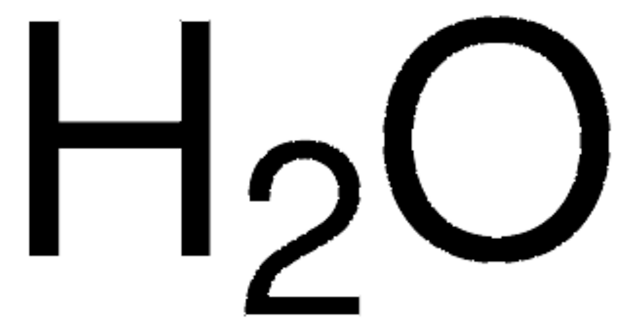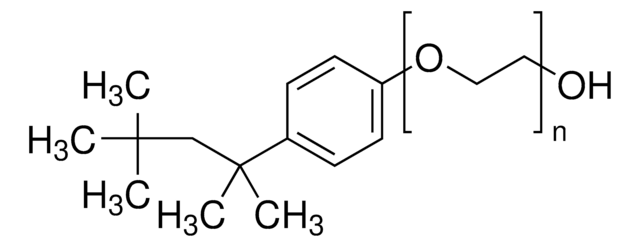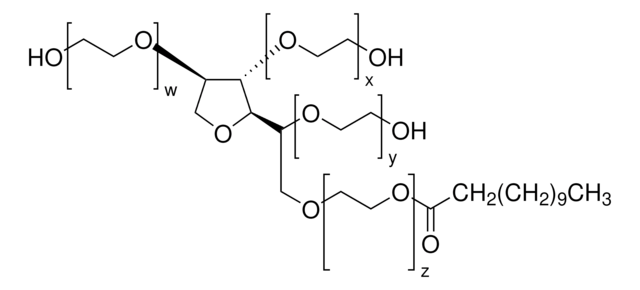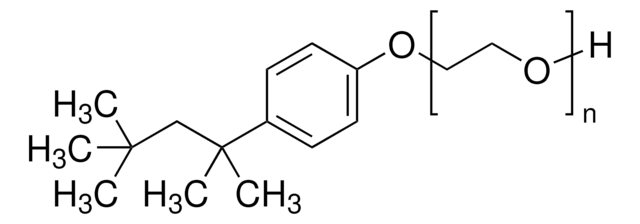61048
Abberior® STAR 488, NHS ester
for STED application
Sign Into View Organizational & Contract Pricing
All Photos(1)
About This Item
UNSPSC Code:
12352200
NACRES:
NA.32
Recommended Products
form
solid
concentration
≥50.0% (degree of coupling)
solubility
DMF: 1 mg/mL, clear
fluorescence
λex 510 nm; λem 514-534 nm in PBS, pH 7.4
storage temp.
−20°C
General description
Abberior STAR 488 is the latest development for STED microscopy. It is a very bright green fluorescent dye that can be very effectively excited at the prominent 488 nm laser line. Abberior STAR 488 can substitute dyes like Oregon Green 488, Atto™ 488 or Alexa Fluor 488.
STED: The dye can most effectively be depleted in STED microscopy at 585-605 nm.
Abberior STAR 488 is the dye of choice for excitation at 488 nm. Even more, the dye is particularly signed and tested for 2-color STED microscopy in combination with our STAR 440SX rusing a 590nm laser. The dye has been very successfully tested in the Leica 2-color TCS STED CW microscope.
Key Features
Absorption Maximum, λmax: 503 nm (PBS, pH 7.4)
Extinction Coefficient, ε(λmax): 65′000 M-1cm-1 (PBS, pH 7.4)
Correction Factor, CF260 = ε260/εmax: 0.28 (PBS, pH 7.4)
Correction Factor, CF280 = ε280/εmax: 0.14 (PBS, pH 7.4)
Fluorescence Maximum, λfl: 524nm (PBS, pH 7.4)
Recommended STED Wavelength, λSTED: 585 - 605 nm
Fluorescence Quantum Yield, η: 0.89 (PBS, pH 7.4)
Fluorescence Lifetime, τ: 3.9 ns (MeOH)
STED: The dye can most effectively be depleted in STED microscopy at 585-605 nm.
Abberior STAR 488 is the dye of choice for excitation at 488 nm. Even more, the dye is particularly signed and tested for 2-color STED microscopy in combination with our STAR 440SX rusing a 590nm laser. The dye has been very successfully tested in the Leica 2-color TCS STED CW microscope.
Key Features
- STED dye of choice at 488 nm excitation
- Ideal depletion behavior in STED microscopy ~590 nm
- 2-color labeling partner with STAR 440SX for 2-color STED microscopy
Absorption Maximum, λmax: 503 nm (PBS, pH 7.4)
Extinction Coefficient, ε(λmax): 65′000 M-1cm-1 (PBS, pH 7.4)
Correction Factor, CF260 = ε260/εmax: 0.28 (PBS, pH 7.4)
Correction Factor, CF280 = ε280/εmax: 0.14 (PBS, pH 7.4)
Fluorescence Maximum, λfl: 524nm (PBS, pH 7.4)
Recommended STED Wavelength, λSTED: 585 - 605 nm
Fluorescence Quantum Yield, η: 0.89 (PBS, pH 7.4)
Fluorescence Lifetime, τ: 3.9 ns (MeOH)
Application
Anti-Rabbit IgG-Abberior® STAR 488 antibody has been used as a secondary antibody:
- for fluorescent immunohistochemistry in prostate cancer cell lines, PPC-1 and TSU-Pr1
- for immunofluorescence in HeLa and monkey kidney COS-7 cells
- for STED (stimulated emission depletion) microscopy in OLN-t40-α-syn cells (oligodendroglial cells)
Suitability
Designed and tested for fluorescent super-resolution microscopy
Other Notes
Legal Information
Atto is a trademark of Atto-Tec GmbH
abberior is a registered trademark of Abberior GmbH
related product
Product No.
Description
Pricing
Storage Class Code
11 - Combustible Solids
WGK
WGK 3
Flash Point(F)
Not applicable
Flash Point(C)
Not applicable
Choose from one of the most recent versions:
Already Own This Product?
Find documentation for the products that you have recently purchased in the Document Library.
Giuseppe Vicidomini et al.
Methods (San Diego, Calif.), 66(2), 124-130 (2013-07-03)
Stimulation emission depletion (STED) microscopy breaks the spatial resolution limit of conventional light microscopy while retaining its major advantages, such as working under physiological conditions. These properties make STED microscopy a perfect tool for investigating dynamic sub-cellular processes in living
Katharina Pukaß et al.
Frontiers in cellular neuroscience, 9, 163-163 (2015-05-23)
α-Synuclein (α-syn) positive glial cytoplasmic inclusions (GCI) originating in oligodendrocytes (ODC) are a characteristic hallmark in multiple system atrophy (MSA). Their occurrence may be linked to a failure of the ubiquitin proteasome system (UPS) or the autophagic pathway. For proteasomal
Combination of axitinib and dasatinib for anti-cancer activities in two prostate cancer cell lines.
Peng N
Bangladesh Journal of Pharmacology, 11, 10-10 (2016)
Marcus Dyba et al.
Nature biotechnology, 21(11), 1303-1304 (2003-10-21)
We report immunofluorescence imaging with a spatial resolution well beyond the diffraction limit. An axial resolution of approximately 50 nm, corresponding to 1/16 of the irradiation wavelength of 793 nm, is achieved by stimulated emission depletion through opposing lenses. We
S W Hell et al.
Optics letters, 19(11), 780-782 (1994-06-01)
We propose a new type of scanning fluorescence microscope capable of resolving 35 nm in the far field. We overcome the diffraction resolution limit by employing stimulated emission to inhibit the fluorescence process in the outer regions of the excitation
Our team of scientists has experience in all areas of research including Life Science, Material Science, Chemical Synthesis, Chromatography, Analytical and many others.
Contact Technical Service




